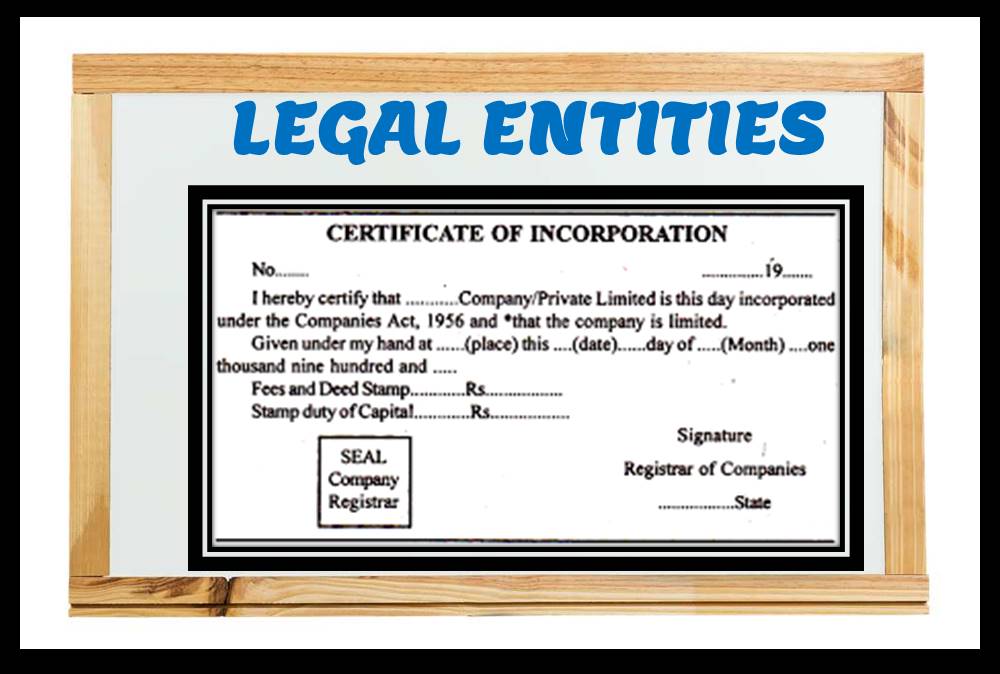- Home
- Business Processes
- Industry Knowledge
- Aerospace Industry
- Automotive Industry
- Banking Domain
- BFSI Industry
- Consumer/ FMCG Industry
- Chemicals Industry
- Engineering & Construction
- Energy Industry
- Education Domain
- Finance Domain
- Hospitality Domain
- Healthcare Industry
- Insurance Domain
- Retail Industry
- Travel and Tourism Domain
- Telecom Industry
- Leadership Skills
- eLearning
- Home
- Business Processes
- General Ledger (Record to Report)
- Concept of Legal Entity
Concept of Legal Entity
A legal entity is an artificial person having separate legal standing in the eyes of law. A Legal entity represents a legal company for which you prepare fiscal or tax reports. A legal entity is any company or organization that has legal rights and responsibilities, including tax filings.
One of the most frequently used terms in the world of compliance and governance is that of the legal entity. But what is the meaning of a legal entity, and why is it so important for finance, compliance, legal and operational professional?
As explained before, A business is entitled enter into commercial transactions due to its charter in the legal system. Commercial groups exist through corporate law. Units in the legal structure of a group are individual companies that share common ownership and control. In a public group, a company is owned by the public through shares sold on a stock market. In a private group, they are held by a privately held holding company. In other organizations, the legal entities are partnerships, funds, or government agencies. A legally recognized entity can own and trade assets and employ people; while an entity without legal recognition cannot. When granted these privileges, legal entities are also assigned responsibilities to account for themselves to the public (statutory reporting and external reporting), comply with legislation and regulations, and pay income or transaction taxes.
What Is a Legal Entity?
A legal entity is an artificial person having separate legal standing in the eyes of law. A Legal entity represents a legal company for which you prepare fiscal or tax reports. A legal entity is any company or organization that has legal rights and responsibilities, including tax filings. It is a business that can enter into contracts either as a vendor or a supplier and can sue or be sued in a court of law. A legal entity can enter into contracts and assume the obligations of those contracts, can borrow and pay debts, can file suits and be named by other parties in suits, and can be held to account for the results of those lawsuits.
Features of Legal Entities
- Legal Entity is also known as GRE - Government Reporting Entity. Some of the attributes associated with legal entity are:
Structure
- A Legal entity is identified through the registration with Legal Authority.
- You assign tax identifiers and other Legal entity information to legal entity
- Legal Entity possesses separate existence for tax purposes. Legal Entities pay the taxes and therefore need tax registrations.
- Legal entities such as parent companies own or control subsidiaries. A large corporation can own many legal entities as its subsidiaries.
Rights & Obligations
- A legal entity has legal capacity to enter into agreements or contracts, assume obligations, incur and pay debts, sue and be sued in its own right, and to be held responsible for its actions.
- Trade between Legal Entities belonging to same corporate is intercompany and must be supported by adequate legal documentation.
- Legal Entities own the money and bank accounts
Compliance & Accounting
- Legal Entities comply with whatever needs compliance – The “Legal” in word “Legal Entity”. This includes recording of all relevant transactions and generating all supporting documents required for financial statements.
- Legal Entities file the accounts and take care of accounting. Legal Entity is the organizational unit for Financial Accounting for which a complete self-contained set of accounts needs to be drawn up for purposes of external reporting.
- Accounting Books must balance at Legal Entity level. This is an entity for which you prepare a trial balance.
Summary
Legal entities are structured in a way that allows for a greater degree of protection for strictly personal assets from lawsuits and regulatory penalties. Each type of entity provides a different set of protections and tax burdens. Legal entity codes are not standardized, despite the globalized economic world in which we live, due to the laws and regulations that govern legal entities fluctuate drastically across jurisdictions.
Related Links
You May Also Like
-
Generally Accepted Accounting Principles define the accounting procedures, and understanding them is essential to producing accurate and meaningful records. In this article we emphasize on accounting principles and concepts so that the learner can understand the “why” of accounting which will help you gain an understanding of the full significance of accounting.
-
Legal Structures in Businesses
Businesses not only vary in size and industry but also in their ownership. Most businesses evolve from being owned by just one person to a small group of people and eventually being managed by a large numbers of shareholders. Different ownership structures overlap with different legal forms that a business can take. A business’s legal and ownership structure determines many of its legal responsibilities.
-
In this article, we explain some commonly used subsidiary ledgers like accounts receivable subsidiary ledger, accounts payable subsidiary ledger or creditors' subsidiary ledger, inventory subsidiary ledger, fixed assets subsidiary ledger, projects subsidiary ledger, work in progress subsidiary ledger, and cash receipts or payments subsidiary ledger.
-
A legal entity is an artificial person having separate legal standing in the eyes of law. A Legal entity represents a legal company for which you prepare fiscal or tax reports. A legal entity is any company or organization that has legal rights and responsibilities, including tax filings.
-
Shared Services is the centralization of service offering at one part of an organization or group sharing funding and resourcing. The providing department effectively becomes an internal service provider. The key is the idea of 'sharing' within an organization or group.
-
Record to report (R2R) is a finance and accounting management process that involves collecting, processing, analyzing, validating, organizing, and finally reporting accurate financial data. R2R process provides strategic, financial, and operational feedback on the performance of the organization to inform management and external stakeholders. R2R process also covers the steps involved in preparing and reporting on the overall accounts.
-
In most of the automated financial systems, you can define more than 12 accounting periods in a financial year. This article will explain the concept of the adjustment period and the benefits of having adjustment periods. Adjustment periods have their inherent challenges for the users of financial statements and there is a workaround for those who don’t want to use adjustment periods.
-
Network Organizational Structures
The newest, and most divergent, team structure is commonly known as a Network Structure (also called "lean" structure) has central, core functions that operate the strategic business. It outsources or subcontracts non-core functions. When an organization needs to control other organizations or agencies whose participation is essential to the success, a network structure is organized.
-
What is a Business Eco System?
The goal of a business is to generate capital appreciation and profits for its owners or stakeholders by engaging in provision of goods and services to customers within the eco system/framework governed by respective laws(local/international). The eco system involves various entities that the business works with for delivery of a product or service.
-
Business Metrics for Management Reporting
Business metric is a quantifiable measure of an organization's behavior, activities, and performance used to access the status of the targeted business process. Traditionally many metrics were finance based, inwardly focusing on the performance of the organization. Businesses can use various metrics available to monitor, evaluate, and improve their performance across any of the focus areas like sales, sourcing, IT or operations.
Explore Our Free Training Articles or
Sign Up to Start With Our eLearning Courses

About Us
Learning
© 2023 TechnoFunc, All Rights Reserved











